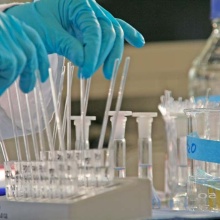Bioprocess Development
IBVT activities for bioprocess development comprise cell-free protein synthesis, microbial and mammalian cells using reactor volumes from μL to 300 L scale. Such studies are intertwined with systems biology and synthetic biology studies to unravel metabolic engineering targets and to understand the cellular interplay with environmental cultivation conditions. Upstream process development is complemented with downstream activities to separate and concentrate products. As such, novel bioprocesses for commodities including biofuels, fine chemicals, flavors and aromatics, cosmetics and biopharmaceuticals are usually developed. Microbial cells such as Escherichia coli, Pseudomonas putida, Corynebacterium glutamicum, Clostridium ljungdahlii, Vibrio natriegens, yeasts such Saccharomyces cerevisiae, or mammalian cells such as Chinese hamster ovary are typically applied.
Metabolomics and Instrumental Analytics
Rational strain developments are based on targeted genetic modifications and require an extensive quantitative understanding of intracellular metabolic networks under varying production-related conditions (Systems Metabolic Engineering). In this regard, IBVT studies focus on the relative and absolute quantification of intra- and extracellular metabolite levels reflecting the actual cellular physiological state. Extracellular measurements of cultivation supernatants allows the determination of consumption and secretion rates of substrates, main and by-products as well as the formulation of mass balances. Newly developed rapid sampling strategies and analytical protocols enable in addition the unbiased quantification of focused intra- and subcellular pathway dynamics using HILIC-based QTOF and QQQ mass spectrometry platforms. Sophisticated 13C isotopic tracer studies facilitates a significantly enhanced information content providing the basis for the model-based analysis of intracellular fluxes (Metabolic Flux Analysis, MFA) and control properties of enzymes under in vivo conditions (Metabolic Control Analysis, MCA).
Scale-Up
The successful transfer of lab results to large-scale production conditions is a sensitive step usually deciding about economic feasibility of a novel process. Often enough, scale-up follows physical criteria that do not adequately reflect the needs of the producing cells. Alternatively, heuristic guidelines are formulated that typically lose validity when novel strains and process conditions are applied. Accordingly, research at IBVT focuses on the elucidation of cellular responses when cells are exposed to fluctuating heterogeneous cultivation conditions of large scale bioreactors. Comprehensive intracellular analysis is performed to monitor intracellular metabolic and regulation dynamics. Such data represent the basis for dynamic cell models that are linked to process models describing micro-environmental heterogeneities. Besides, data sets are taken as blueprints to derive metabolic engineering strategies for the creation of robust microbial chassis for large scale application.
Strain Development
Strain construction at IBVT harnesses Metabolic Engineering and Systems Biology tools as well as Synthetic Biology approaches to exploit the potential of established and novel microbial systems for Industrial Biotechnology. The three areas are closely interlinked with the aim to generate a quantitative and systemic understanding of the metabolic functions of the microbial platforms Escherichia coli, Vibrio natriegens, Pseudomonas putida, Hydrogenophaga pseudoflava and Corynebacterium glutamicum. Genetic engineering is knowledge-driven and consequently based on metabolomics and supported by modeling approaches to design tailored microbial cell factories for the production of fuels and chemicals.
in vitro Protein Synthesis
Cell-free (in vitro) protein synthesis exploit DNA-fragments, plasmids or isolated genes which are transcribed by RNA polymerases of the cell extract coupled with translation by ribosomes. (A. S. Spirin, 1988, Science). It is a highly versatile protein production system for in vitro synthetic biology. Translation performance of this reaction depends on highly active cytoplasmic extracts, which provide the translation machinery such as ribosomes and other translation factors. Or goal is to optimize cell-free systems for profound in vitro protein production by identifying systems-limiting factors using Systems Biology approaches. Current investigations are focused on the analytical analysis of the (i) ribosomal apparatus, (ii) energy regeneration metabolism, and (iii) its global, detailed mathematical description.
Bioinformatics
Algorithms
Modern high-throughput methods in the fields of genomics and transcriptomics need efficient algorithms for their analysis. This requires to combine efficient data structures (e.g. deBruijn-Graphs, indexes) with suitable optimisation technologies (e.g. dynamic programming) and to integrate these into usable tools.
Pipelines
Analysing high-throughput data sets is not performed with single algorithms or tools, but rather with sophisticated combinations of diverse computational methods. Such workflows or pipelines are often implemented as scripts in languages like Python or Perl. Additionally, more user-friendly, web-based systems have gained popularity throughout recent years, where the Galaxy Project is the most widely distributed and accepted framework.
HPC & Grid-Computing
The actual application of algorithms, pipelines and workflows on large data sets requires the use of high-performance computing infrastructure and a high level of data integration in order to achieve reasonable results. Runnning and using state-of-the-art grid systems (local and at the HLRS) is also one of our core competences.
Modeling
Classical black-box modelling approaches are applied to design novel bioprocesses from lab to production scale. Besides, compartmented bioreactor models are used to consider heterogeneity zones of large scale tanks. Such approaches are further refined by computational fluid dynamics to simulate the cell-bioreactor interplays. Euler-Euler or Euler-Lagrangian approaches are used to track individual cells thereby monitoring individual travelling and stimulus histories.
Subcellular modelling comprises stoichiometric genome-scale flux analysis, 13C flux analysis and gene regulatory models based on experimental data. Modelling of intracellular mechanisms comprises detailed modelling of transcription and translation and the identification of metabolic engineering targets via stimulus/response analysis identifying and exploiting dynamic models.




